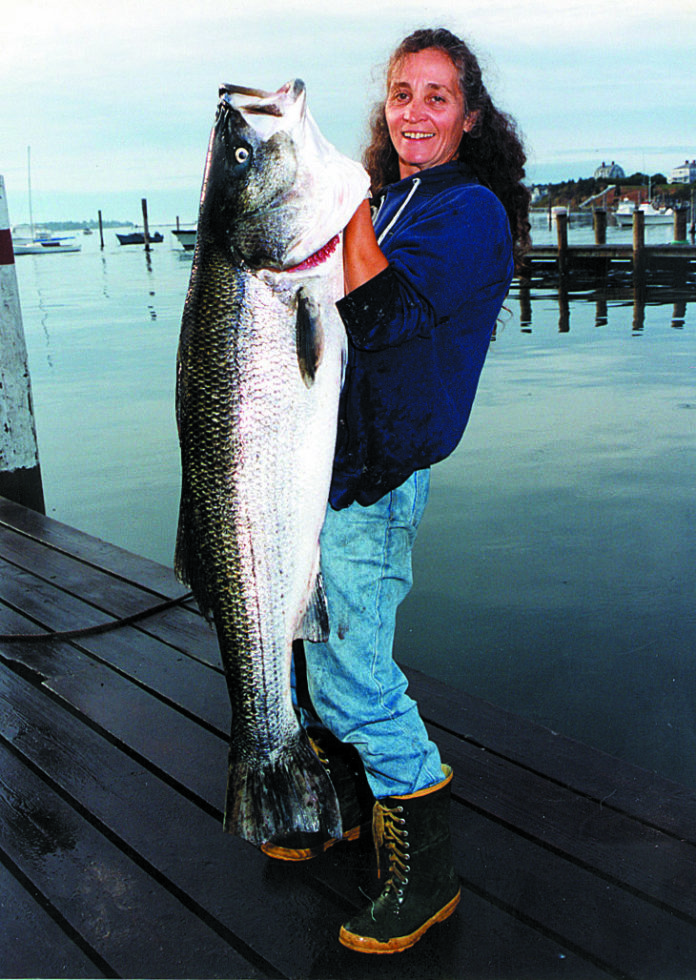
Every fall on Martha’s Vineyard, anglers come from far and wide to participate in a fishing tournament. They compete for more than thirty days for daily, weekly, and grand prizes that range from pins and lures, to a brand new boat. The tournament focuses a considerable amount of energy on its impact in the community by supporting scholarships and using the fish that typically would feed elders at senior centers after weigh-in (we are not sure of this year’s plans, at press time). It is a tournament steeped in tradition, sportsmanship, legend, and altruism.
Stripers furloughed for now
Most who follow the Martha’s Vineyard Striped Bass and Bluefish Derby (the Derby), have heard by now that the striped bass species has been removed from the 75th Derby. Fishing for these beautiful fish is an art that requires dedication, patience, and often sleep deprivation. I have spent many sleepless nights patrolling the beaches of the Island in hopes of catching a worthy striper. Personally, though I was saddened to hear that this pinnacle species would be omitted from the competition, I understood the move to be in the best interest of preservation, and wanted to learn more about the decision from someone with a lot more Derby experience than myself. I caught up with author, angler, and beloved Island taxidermist, Janet Messineo to discuss the Derby without its namesake fish.
When I spoke to Janet, she had just come back from a fishing trip to the Cape Cod Canal, a legendary location for catching monster striped bass. “Seventy-three years old and I’m still doing it, not like I used to, but I’m still doing it,” she said.
Janet began fishing on the Island when it was uncommon for women to fish, but through hard work and determination she has become a legendary Island fisherman. She quickly pointed out that this is not the first time striped bass have been removed from the competition. “I was here the first time they didn’t have bass in the Derby.” In 1984 Janet came in second place in the category with a 45-pound fish. “Back then, fish like that were more common. I wanted to mount a 50-pounder,” she told me. But knowing there would be no striped bass in the Derby the following year, and not knowing when they would come back to the tournament, she decided to mount her second place catch. “That was the fish that got me into taxidermy,” she said. Janet went on to become a premier skin mount taxidermist for many years after graduating from the Pennsylvania Institute of Taxidermy, though now she is mostly retired.
From 1985 to 1993 striped bass were removed from the competition in efforts to support conservation. “There was a lot of concern that the commercial fishing industry would collapse back then,” she said. Even after the species was reintroduced in 1993 there was no monetary prize associated with striped bass. “Buck Martin won with a 54-pounder,” she remembered, “but there was no money.” Janet seems to remember almost every Derby-winning fish. Not that I doubted her, but I checked the records and indeed Buck Martin’s 1993 fish was 54.74 pounds. The only prize given was a trophy that Janet herself made.
Historically the Derby has made efforts to help the striped bass species and this year’s decision is in line with that tradition. The committee considered a catch and release tournament for striped bass, but “The [fewer] people you have targeting a resource, the better it is for that resource,” Janet explained. To Janet, fishermen in general care about conservation. “We care about the fish, the beaches, the ocean, and the people. The Derby is all about scholarships, and that is who fishermen are.” She was also quick to say “Women are fishermen too!” and in fact it is quite common for women to be respectfully referred to as fishermen in the fishing world.
The decision to suspend stripers was not taken lightly, and is ultimately more a symbolic move than anything else. Last year’s Derby drew in nearly 3,000 anglers from around the world last year, and in the 30 plus days there were a little more than 300 striped bass weighed in, “a far cry from the canal. The canal takes two times as many fish per day as the entire Derby,” Janet said. Although the Cape Cod Canal is closed to commercial fishing this year, it is a mecca for recreational anglers.
As of the writing of this article, the 75th Derby is still slated to take place from Sunday, September 13 through Saturday, October 17, 2020. We are all hoping that the committee can provide a safe and fun tournament amidst the pandemic. Though I speculate that weigh in and the awards ceremony will likely not resemble years past, anglers are generally excellent at social distancing.
On a positive note, there are large numbers of small striped bass all over Island waters, giving hope that with proper respect for the species the population will grow. Janet sees the move as a positive step in the right direction so that the species can survive for many generations to come. For her it’s about respect, “not just for your generation, but for your children and grandchildren too,” she said.
Despite the lack of the striped bass, I for one am still very much looking forward to the Derby. The competition still includes bluefish, false albacore and bonito, all of which are a blast to fish for. This year we have already seen signs that the bonito may arrive in large numbers again, and the fishing has been generally fantastic.
Last year the bonito came in early, and in large numbers that haven’t been seen in years. Countless anglers were catching their first shore bonito throughout August and into the Derby. Before the Derby even started, anglers were making trips to the Vineyard to try their luck. This year reports of bonito being caught in Island waters started coming in as early as June, and it looks like it could be another fantastic year.
There are other fish in the sea
As a chef who also loves to fish, bonito are for me a perfect confluence of the two disciplines. Bonito can be quite picky and thus difficult to catch, but waking up for first light, following the tides, and keeping your line in the water will put you at an advantage. Though you sometimes see them breaking, blind casting has produced some of the largest bonito I have seen. They are fast and strong, making them excellent sport fish, and their flesh is firm and extremely mild making them an excellent candidate for raw and cooked preparation. The other advantage to targeting bonito is, they often travel quite closely with false albacore. Albies are even stronger and faster than the bonito and often hit the same lures, though they are not nearly as palatable.
Bluefish are also quite fun to catch. They are notorious for striking just about any kind of lure, put up a great fight, and can be targeted broadly and at almost any time of day. They are excellent to eat, though they do need to be handled properly. The one word of advice I would offer for inexperienced anglers, is to steer clear of their teeth. Bluefish have very sharp teeth that have been responsible for countless tales of cuts, stitches, and worse.
Hopefully conservation efforts by states and competitions like the Martha’s Vineyard Striped Bass & Bluefish Derby will allow the population of striped bass in the Atlantic Ocean to flourish with time. It may be years before we see striped bass in the Derby again, but as participants, we will have all done a small part to give back to the health of the ocean’s ecosystem, and preserve the species for future generations, because as Janet put it “That’s who fishermen are.”

